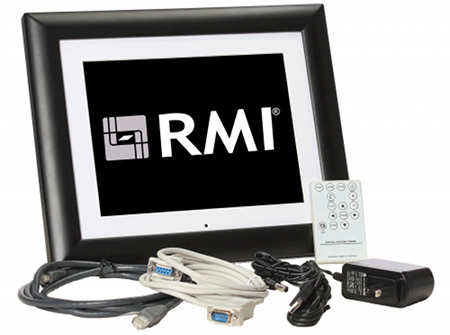Linux development kit supports DPFs and MIDs
Apr 23, 2009 — by Eric Brown — from the LinuxDevices Archive — 36 views RMI Corp. announced the availability of a WiFi-enabled hardware/software development kit for digital picture frames (DPFs) and mobile Internet devices (MIDs). The Home Media Player (HMP) Application Development Kit (ADK) is based on RMI's MIPS-architecture Au1250 processor, and includes a Linux Board Support Package (BSP).
RMI Corp. announced the availability of a WiFi-enabled hardware/software development kit for digital picture frames (DPFs) and mobile Internet devices (MIDs). The Home Media Player (HMP) Application Development Kit (ADK) is based on RMI's MIPS-architecture Au1250 processor, and includes a Linux Board Support Package (BSP).
(Click for larger view of the Home Media Player development board)
RMI's Alchemy-family Au1250 SoC was announced in January 2007 in versions clocked to 600MHz. The SoC offers an on-chip media acceleration engine that provides hardware-based D1 (up to 720 x 480) video processing, making it ideally suited for use in PMPs, according to RMI.
In January 2008, RMI introduced a 700MHz version of the Au1250. While using under 700mW of power, the upgrade can simultaneously play digital video at 2Mbps, D1 resolution, while also enabling active IDE hard drive and display usage and keeping all on-chip peripherals active except for USB 2.0 ports, claimed RMI at the time. This year, RMI introduced a similar Au1300 SoC, clockable to 1GHz, and touted for using half a Watt to decode 720p video.

RMI's acronym-rich HMP ADK for DPFs and MIDs
(Click to enlarge)
RMI does not list many hardware details about the ADK, except to say that it includes RMI's Au1250-based development board along with a 10.4-inch LCD, featuring a resolution of 1024 x 768 pixels. The system ships with 256MB of DDR2 RAM and 2GB of NAND flash, as well as an Atheros WiFi radio, says RMI. Additional features are said to include two USB ports, Ethernet and serial ports, stereo speakers, an IR receiver, and a 5-in-1 card reader.
The ADK is built around a Linux OpenEmbedded distribution and BSP running Linux 2.6. It includes the CoreCodec media stack and player for D1 resolution video playback for MPEG-1/2/4, VC1/WMV, H.264, DivX, and XviD, says the company. It is also said to offer hardware-accelerated DirectFB, GTK+ middleware, toolchain, filesystem, and an example application.
CoreCodec and FrameMedia chip in on multimedia
In addition to offering CoreCodec's CorePlayer media player and codecs, the HMP design includes the company's CoreUI technology. Together with the Linux development environment, these tools are said to enable third-party developers to add audio, video, and picture support to their HMP applications.
The design also includes unspecified content and tools from wireless DPF technology vendor FrameMedia. Its FrameChannel content delivery software for WiFi photo frames is said to enable customer programming of content that is dynamically updated, combining the customer's own photos with content from a library of hundreds of channels ranging from news to photographic imagery. In addition, FrameMedia has begun development on its own version of the HMP ADK equipped with a multi-stream RSS reader with multimedia capabilities.
Features supported by the HMP design include:
- 30fps transitions between slideshows
- Gamma corrected image enhancement
- Connects to PCs and Macs over home network
- Tightly integrated with online photo services such as Flickr
and Picassa - D1 video player
- Music player with album art and lyrics
- Multiple Internet radio and music services with free and premium subscription options
- YouTube integration
- Links to other online streaming TV sites
- Premium live TV and themed video options
- WebKit-based Internet dashboards
- Real-time news, weather and sports scores
- Custom themed “mashups” such as Sports, Cuisine, Retail, and TV
- Personalized settings and WiFi setup
- FrameMedia and FrameIT Certification
- Backend Server
RMI says it will work directly with customers on specific solutions, recommending and managing ODMs that are familiar with HMP designs and BOM requirements. RMI also says it will provide the complete BOM for the reference design kit, and offer support through the ramp up and into production. In addition to being useful for DPFs, the HMP player design could be useful for digital signage, information dashboards, and “other home networking and consumer devices,” the company adds.
Stated Mike Wodopian, VP and GM of RMI, “This ADK is the first step in changing the paradigm in the wireless DPF and MID markets. As the open development environment is cultivated, more and more applications and features will be enabled, allowing OEMs to quickly and thoroughly differentiate their solutions.”
Stated Dan Marlin, CEO of CoreCodec, “This ADK raises the bar for digital photo frame and portable media player device capabilities, while significantly reducing OEM time to market.”
RMI's announcement was made at the NAB show, and came on the same day that embedded development firm Embedded Alley announced it was working with semiconductor vendor RMI to port the Google-sponsored, open-source smartphone stack, Android, to RMI's Au1250. The port would be the first for Android to a MIPS-architecture system-on-chip (SoC). DPFs and MIDs were both listed as devices that would be good candidates to run the Android stack.
Availability
The Home Media Player ADK is available now from RMI for $500. More information may be found here.
This article was originally published on LinuxDevices.com and has been donated to the open source community by QuinStreet Inc. Please visit LinuxToday.com for up-to-date news and articles about Linux and open source.